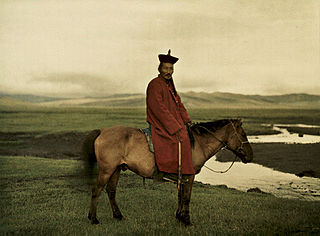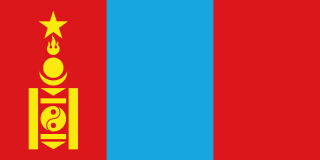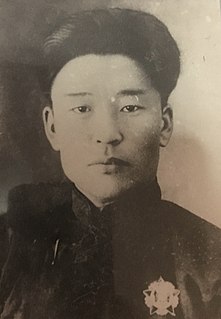
The Mongols are an East Asian ethnic group native to Mongolia and to China's Inner Mongolia Autonomous Region. They also live as minorities in other regions of China, as well as in Russia. Mongolian people belonging to the Buryat and Kalmyk subgroups live predominantly in the Russian federal subjects of Buryatia and Kalmykia.

Mongolia is a landlocked country in East Asia. Its area is roughly equivalent with the historical territory of Outer Mongolia, which is sometimes used to refer to the current state. It is situated between Russia to the north and China to the south, where it neighbours the Inner Mongolia Autonomous Region. Mongolia does not share a border with Kazakhstan, although only 37 kilometres separate them.

Inner Mongolia or Nei Mongol, officially the Inner Mongolia Autonomous Region, is a landlocked and Mongolic autonomous region of the People's Republic of China. Its border includes most of the length of China's border with the country of Mongolia. Inner Mongolia also accounts for a small section of China's border with Russia. Its capital is Hohhot; other major cities include Baotou, Chifeng, Tongliao and Ordos.

Ulaanbaatar, formerly anglicised as, Ulan Bator, is the capital and largest city of Mongolia. The city is not part of any aimag (province), and its population as of 2014 was over 1.3 million, almost half of the country's population. The municipality is in north central Mongolia at an elevation of about 1,300 metres (4,300 ft) in a valley on the Tuul River. It is the country's cultural, industrial and financial heart, the centre of Mongolia's road network and connected by rail to both the Trans-Siberian Railway in Russia and the Chinese railway system.

Northern Mongolia was a territory of the Qing dynasty (1691–1911). Its area was roughly equivalent to that of the modern state of Mongolia, sometimes called "Northern Mongolia" in China today, plus the Russian republic of Tuva.
Mongolian is the official language of Mongolia and both the most widely spoken and best-known member of the Mongolic language family. The number of speakers across all its dialects may be 5.2 million, including the vast majority of the residents of Mongolia and many of the ethnic Mongol residents of the Inner Mongolia Autonomous Region of the People's Republic of China. In Mongolia, the Khalkha dialect is predominant, and is currently written in both Cyrillic and traditional Mongolian script, while in Inner Mongolia, the language is dialectally more diverse and is written in the traditional Mongolian script.

The Mongolic languages are a group of languages spoken in Eastern Europe, North Asia and East Asia, mostly in Mongolia and surrounding areas and in Kalmykia and Buryatia. The best-known member of this language family, Mongolian, is the primary language of most of the residents of Mongolia and the Mongol residents of Inner Mongolia, with an estimated 5.7+ million speakers.

The Mongolian People's Republic was a unitary sovereign socialist state which existed between 1921 and 1992, coterminous with the present-day country of Mongolia in East Asia. It was ruled by the Mongolian People's Revolutionary Party and maintained close links with the Soviet Union throughout its history. Geographically, it was bordered by China to its south and the Soviet Union to its north. Until 1944, it also bordered the Tuvan People's Republic, a Soviet satellite state recognized only by Mongolia and the Soviet Union.

Mongolia is divided into 21 provinces or aimags and one provincial municipality. Each aimag is subdivided into several districts. The modern provinces have been established since 1921. The capital, Ulaanbaatar, is governed as an independent provincial municipality separate from Töv Province, inside which it is situated.

Khovd or Hovd, formerly known as Kobdo or Khobdo, is the capital of the Khovd Province of Mongolia. It is officially known as Jargalant sum.

Buddhism is the largest religion of Mongolia practiced by 53% of Mongolia's population, according to the 2010 Mongolia census. Buddhism in Mongolia derives much of its recent characteristics from Tibetan Buddhism of the Gelug and Kagyu lineages, but is distinct and presents its own unique characteristics.

The classical or traditional Mongolian script, also known as the Qudum Mongγol bičig, was the first writing system created specifically for the Mongolian language, and was the most widespread until the introduction of Cyrillic in 1946. It is traditionally written in vertical lines Top-Down, right across the page. Derived from the Old Uyghur alphabet, Mongolian is a true alphabet, with separate letters for consonants and vowels. The Mongolian script has been adapted to write languages such as Oirat and Manchu. Alphabets based on this classical vertical script are used in Inner Mongolia and other parts of China to this day to write Mongolian, Xibe and experimentally, Evenki.

The Mongolian Revolution of 1990 was a peaceful democratic revolution that started with demonstrations and hunger strikes to overthrow the Mongolian People's Republic and eventually moved towards the democratic present day Mongolia and the writing of the new constitution. It was spearheaded by mostly younger people demonstrating on Sükhbaatar Square in the capital Ulaanbaatar. It ended with the Communist government resigning without bloodshed. Some of the main organizers were Davaadorjiin Ganbold, Tsakhiagiin Elbegdorj, Sanjaasürengiin Zorig, Erdeniin Bat-Üül, Bat-Erdeniin Batbayar, and Dogmidiin Sosorbaram.

Genghis Khan, was the founder and first Great Khan (Emperor) of the Mongol Empire, which became the largest contiguous empire in history after his death. He came to power by uniting many of the nomadic tribes of Northeast Asia. After founding the Empire and being proclaimed Genghis Khan, he launched the Mongol invasions that conquered most of Eurasia, reaching as far west as Poland in Europe and the Levant in the Middle East. Campaigns initiated in his lifetime include those against the Qara Khitai, Khwarezmia, and the Western Xia and Jin dynasties, and raids into Medieval Georgia, the Kievan Rus', and Volga Bulgaria. These campaigns were often accompanied by large-scale massacres of the civilian populations, especially in the Khwarazmian and Western Xia-controlled lands. Because of this brutality, which left millions dead, he is considered by many to have been a brutal ruler. By the end of his life, the Mongol Empire occupied a substantial portion of Central Asia and China. Due to his exceptional military successes, Genghis Khan is often considered to be the greatest conqueror of all time.

The Bogd Khanate of Mongolia was the government of Mongolia between 1911 and 1919 and again from 1921 to 1924. By the spring of 1911, some prominent Mongolian nobles including Prince Tögs-Ochiryn Namnansüren persuaded the Jebstundamba Khutukhtu to convene a meeting of nobles and ecclesiastical officials to discuss independence from the Manchu-led Qing China. On November 30, 1911 the Mongols established the Temporary Government of Khalkha. On December 29, 1911 the Mongols declared their independence from the collapsing Qing Empire following the Xinhai Revolution. They installed as theocratic sovereign the 8th Bogd Gegeen, highest authority of Tibetan Buddhism in Mongolia, who took the title Bogd Khaan or "Holy Ruler". The Bogd Khaan was last khagan of Mongolia. This ushered in the period of "Theocratic Mongolia", also known as the Bogd Khanate.
Various nomadic empires, including the Xiongnu, the Xianbei state, the Rouran Khaganate (330–555), the First (552–603) and Second Turkic Khaganates (682–744) and others, ruled the area of present-day Mongolia. The Khitan people, who used a para-Mongolic language, founded an empire known as the Liao dynasty (916–1125) and ruled Mongolia and portions of the present-day Russian Far East, northern Korea, and North China.

Mongolian shamanism, more broadly called the Mongolian folk religion, or occasionally Tengerism, refers to the animistic and shamanic ethnic religion that has been practiced in Mongolia and its surrounding areas at least since the age of recorded history. In the earliest known stages it was intricately tied to all other aspects of social life and to the tribal organization of Mongolian society. Along the way, it has become influenced by and mingled with Buddhism. During the socialist years of the twentieth century it was heavily repressed and has since made a comeback.

Banzarjavyn Baasanjav was leader of the Mongolian People's Revolutionary Party from 1936 to 1940. Prime Minister Khorloogiin Choibalsan arranged for his arrest and subsequent execution on charges of counterrevolution in 1940 to free up the party leadership role for Yumjaagiin Tsedenbal.

The COVID-19 pandemic was confirmed to have reached Mongolia when its first case was confirmed in a French man who traveled from Moscow to Dornogovi on 10 March 2020.
















